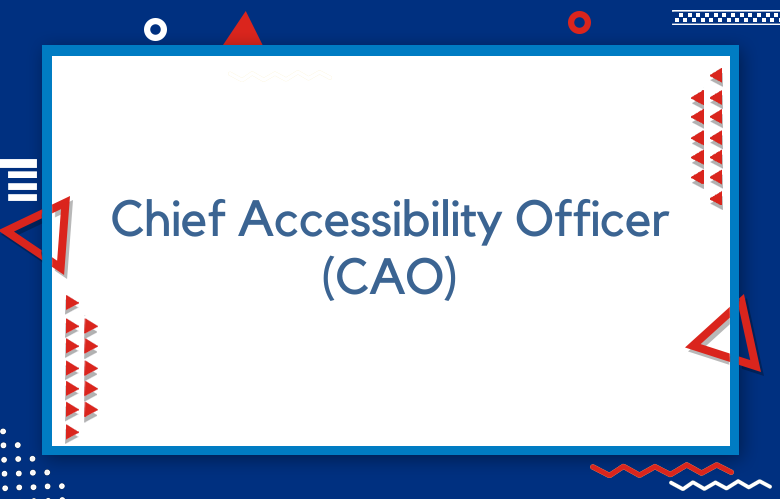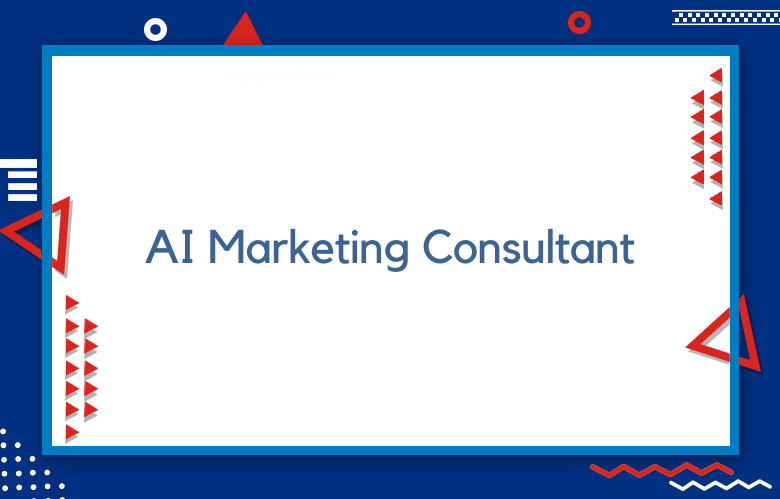Chief Accessibility Officer (CAO) Role and Responsibilities

As organizations strive to create inclusive and accessible environments for all stakeholders, the role of the Chief Accessibility Officer (CAO) has become increasingly important.
The CAO is responsible for ensuring that organizations comply with accessibility regulations and standards and that their products, services, and digital platforms are accessible and usable by people with disabilities.
Chief Accessibility Officer (CAO) Role and Responsibilities
The chief Accessibility Officer (CAO) has a critical role in ensuring that organizations provide equal access and opportunity to all individuals, regardless of their abilities or disabilities.
The CAO is responsible for developing and implementing accessibility policies, identifying and removing accessibility barriers, advocating for accessibility within the organization, and ensuring compliance with accessibility regulations.
The CAO’s role is crucial in creating a more inclusive and equitable society. Organizations that invest in accessibility are better positioned to attract and retain a diverse workforce, reach a broader customer base, and build a positive reputation. By embracing accessibility as a core value and investing in the CAO role, organizations can create a more inclusive and accessible future for all.
The CAO’s responsibilities include:
Developing and Implementing Accessibility Strategy
The CAO is responsible for developing and implementing an accessibility strategy that aligns with the organization’s overall objectives and priorities. This strategy should encompass all aspects of accessibility, including compliance with regulations and standards, the design and development of accessible products and services, and providing accessibility training and support to employees.
Ensuring Compliance with Accessibility Regulations and Standards
The CAO ensures that the organization complies with all relevant accessibility regulations and standards, including the Americans with Disabilities Act (ADA) and the Web Content Accessibility Guidelines (WCAG). This involves conducting regular accessibility audits, identifying and addressing accessibility issues, and developing and implementing remediation plans.
Providing Accessibility Training and Support to Employees
The CAO provides accessibility training and support to employees, ensuring they have the knowledge and skills to create accessible products, services, and digital platforms. This involves developing and delivering training programs, providing ongoing support and guidance, and monitoring the effectiveness of accessibility initiatives.
Collaborating with Other Departments
The CAO collaborates with other departments, such as human resources, information technology, and marketing, to ensure that accessibility is integrated into the organization’s operations. This collaboration is essential to embedding accessibility into the organization’s culture and decision-making processes.
Monitoring Accessibility Performance
The CAO monitors the organization’s accessibility performance, assessing the effectiveness of accessibility initiatives, identifying areas for improvement, and developing strategies to enhance accessibility across the organization.
Advocating for Accessibility
The CAO champions accessibility within the organization, advocating for accessibility in all aspects of the organization’s operations and working to create a culture of accessibility.
Unveiling the Untapped Potential: The Rise of the Chief Accessibility Officer
As society increasingly recognizes the importance of accessibility and inclusion, the Chief Accessibility Officer (CAO) role has emerged as a critical position in organizations across industries. The CAO is responsible for ensuring that products, services, and digital platforms are accessible and usable by people with disabilities, helping to create a more inclusive and equitable society.
Traditionally, accessibility has been seen as a niche area, often relegated to a lower priority within organizations. However, as awareness of its importance grows, the CAO’s role has become increasingly important. By leading accessibility initiatives, the CAO helps organizations attract and retain a diverse workforce, reach a broader customer base, and build a positive reputation as a socially responsible organization.
From Inclusion to Innovation: The Evolving Role of the CAO
The role of the Chief Accessibility Officer (CAO) has significantly evolved in recent years as organizations increasingly recognize the importance of accessibility and the value of creating inclusive and accessible environments for all stakeholders. Traditionally, the CAO’s primary focus has been ensuring compliance with accessibility regulations and standards and removing accessibility barriers.
However, as organizations become more aware of the benefits of accessibility, the CAO’s role has expanded to include a broader range of responsibilities, including driving innovation, enhancing user experience, and creating a more inclusive and equitable workplace. In this evolving landscape, the CAO’s role is more critical than ever, as they play a crucial role in shaping the organization’s accessibility strategy and championing accessibility as a core value.
The Accessibility Advocate: How the CAO is Transforming Business Strategies
The Chief Accessibility Officer (CAO) is a relatively new but increasingly important role in organizations, particularly as businesses become more aware of the importance of accessibility in their products, services, and environments. The CAO is responsible for leading the organization’s efforts to make its offerings accessible to all users, including people with disabilities. This role is transformative for business strategies in several key ways:
Enhancing Brand Image and Reputation
By prioritizing accessibility, companies can improve their brand image and reputation. Demonstrating a commitment to inclusivity can resonate positively with consumers, employees, and stakeholders, showing that the company values diversity and provides equitable experiences for all.
Expanding Market Reach
Accessibility initiatives can open up products and services to a broader audience, including the approximately 1 billion people worldwide with some form of disability. By making products and services more accessible, companies can tap into new market segments and increase their customer base.
Legal Compliance and Risk Management
Many regions have laws and regulations requiring digital and physical accessibility, such as the Americans with Disabilities Act (ADA) in the United States and the European Accessibility Act in the EU. The CAO helps ensure compliance with these regulations, reducing the risk of legal challenges and associated financial penalties.
Innovation and Product Development
Accessibility challenges often lead to innovative solutions that can benefit all users. For example, voice-controlled devices and interfaces were initially developed to assist individuals with mobility and dexterity issues but have become widely popular among the general population. The CAO can drive such innovations by integrating accessibility into product development.
Employee Engagement and Diversity
Organizations can attract and retain a diverse workforce by fostering an inclusive work environment. This diversity can lead to a more creative, innovative, and productive workforce. The CAO plays a crucial role in building an inclusive culture that supports employees of all abilities.
Customer Satisfaction and Loyalty
Accessible products and services can lead to higher customer satisfaction, particularly among users with disabilities who may have had negative experiences with other companies’ offerings. Satisfied customers are more likely to be loyal and to recommend the company to others.
Breaking Barriers: The CAO’s Journey towards Equal Access for All
The journey of a Chief Accessibility Officer (CAO) towards achieving equal access for all is both challenging and rewarding. It involves a multifaceted approach that includes organizational change, technological innovation, and cultural shifts. Here’s an overview of the critical steps and initiatives involved in this journey:
Assessment and Baseline Setting
The CAO begins by conducting a comprehensive assessment of the organization’s current accessibility status. This involves evaluating products, services, and environments against accessibility standards and guidelines like the Web Content Accessibility Guidelines (WCAG). Establishing a baseline is crucial for measuring progress.
Strategic Planning and Policy Development
Based on the initial assessment, the CAO develops a strategic plan that outlines the organization’s accessibility goals, priorities, and timelines. This plan includes formulating policies and procedures that embed accessibility into every aspect of the organization’s operations, from procurement and product development to marketing and customer service.
Building Internal Capacity
To ensure the successful implementation of accessibility initiatives, the CAO focuses on building internal capacity. This involves training employees on accessibility principles and practices, establishing dedicated accessibility teams, and integrating accessibility considerations into existing roles and responsibilities.
Technological Innovation and Integration
The CAO champions adopting accessible technologies and developing new solutions to meet the diverse needs of users with disabilities. This includes leveraging assistive technologies, ensuring compatibility with various devices and platforms, and adopting inclusive design principles in product development.
Stakeholder Engagement and Collaboration
The CAO engages with various stakeholders, including people with disabilities, advocacy groups, industry partners, and regulatory bodies. This engagement helps to ensure that the real-world experiences and needs inform the organization’s accessibility initiatives for users with disabilities.
Monitoring, Evaluation, and Continuous Improvement
The CAO establishes mechanisms for monitoring and evaluating accessibility initiatives on an ongoing basis. This involves collecting and analyzing data, soliciting feedback from users with disabilities, and conducting regular audits and reviews. Insights gained from these activities inform continuous improvement efforts.
Leading the Change: Exploring the CAO’s Impact on Organizational Culture
The Chief Accessibility Officer (CAO) has the unique opportunity to ensure organizational compliance with accessibility regulations and drive a cultural shift towards a more inclusive and equitable workplace.
By championing accessibility initiatives and leading by example, the CAO can profoundly impact organizational culture and influence employees’ attitudes, beliefs, and behaviors at all levels.
One fundamental way the CAO can impact organizational culture is by fostering a mindset of accessibility as a strategic advantage rather than a compliance requirement.
By highlighting accessibility’s benefits for the organization, such as enhanced user experience, increased market share, and improved employee engagement, the CAO can encourage employees to embrace accessibility as a core value and a strategic priority.
Pioneering Accessibility: The CAO’s Responsibilities in a Digitally Driven World
In today’s digital age, accessibility has become critical to a successful and inclusive digital strategy. As organizations rely more heavily on technology to engage with customers, employees, and stakeholders, ensuring that digital assets and experiences are accessible to all is essential. The Chief Accessibility Officer (CAO) is vital in championing accessibility in this increasingly digital world.
One of the CAO’s critical responsibilities is to ensure that all digital assets and experiences, including websites, apps, and social media, are accessible and compliant with applicable laws and guidelines. This includes conducting regular accessibility audits, identifying barriers, and recommending solutions to ensure that all digital assets and experiences meet the highest accessibility standards.
Conclusion
The CAO plays a critical role in ensuring that organizations comply with accessibility regulations and standards and that their products, services, and digital platforms are accessible and usable by people with disabilities.
By developing and implementing an accessibility strategy, ensuring compliance with accessibility regulations and standards, providing accessibility training and support to employees, collaborating with other departments, monitoring accessibility performance, and advocating for accessibility, the CAO helps organizations create inclusive and accessible environments for all stakeholders.



